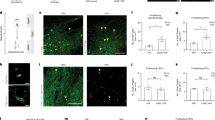Abstract
DRUG tolerance is characterised by a loss of sensitivity to the pharmacological properties of a drug as a result of repeated exposure. Because it can be produced by both intravenous and intracerebral injection of opiates or barbiturates1–3, functional alteration of neural cells probably contributes to its development. The identification of mechanisms underlying the development of tolerance to morphine in the central nervous system is complicated by secondary drug-induced changes in bioelectrical and metabolic activity. This can be circumvented by the use of a mirror-focus preparation where comparison of the drug-treated region in one hemisphere can be made with the morphological homologue in the contralateral hemisphere. For example, Morrell4 induced bilateral epilepsy after unilateral treatment with an irritant that causes the epileptic discharge pattern to be propagated, through the commissural projections, to the mirror-focus cells in the opposite hemisphere. Since the mirror-focus cells are never in direct contact with the epileptogenic agents, any alteration in their metabolism is due solely to epilepsy. Similarly, seizures generated by electrical stimulation of one amygdala propagate to the contralateral amygdala4,5. Since the anterior amygdala of the rat has a high concentration of opiate receptors6, we have used it to investigate the effects of direct unilateral injection of morphine sulphate. We found that injections of opiates such as morphine and levorphanol produce seizures at the injection site that propagate to the mirror-focus in the contralateral hemisphere. Tolerance to opiates develops at the injection site but the mirror-focus retains normal sensitivity to opiates in spite of the shared epileptiform activity.
This is a preview of subscription content, access via your institution
Access options
Subscribe to this journal
Receive 51 print issues and online access
$199.00 per year
only $3.90 per issue
Buy this article
- Purchase on Springer Link
- Instant access to full article PDF
Prices may be subject to local taxes which are calculated during checkout
Similar content being viewed by others
References
Lotti, V. J., Lomax, P., and George, R., Int. J. Neuropharmac., 5, 35–42 (1966).
Jaffe, J., and Sharpless, S. K., Pharmacologist, 5, 249 (1963).
Mycek, M. J., and Brezenoff, H. E., Fedn Proc., 33, 527 (1974).
Morrell, F., in Chemical Modulation of Brain Function (edit. by Sabelli, H. C.) (Raven, New York, 1973).
Goddard, G. V., Nature, 214, 1020–1021 (1967).
Kuhar, M. J., Pert, C. B., and Snyder, S. H., Nature, 245, 447–450 (1973).
Author information
Authors and Affiliations
Rights and permissions
About this article
Cite this article
TEITELBAUM, H., BLOSSER, J. & CATRAVAS, G. Bilateral electroencephalographic response and unilateral tolerance to unilateral intracerebral morphine injections. Nature 260, 158–159 (1976). https://doi.org/10.1038/260158a0
Received:
Accepted:
Issue Date:
DOI: https://doi.org/10.1038/260158a0
This article is cited by
Comments
By submitting a comment you agree to abide by our Terms and Community Guidelines. If you find something abusive or that does not comply with our terms or guidelines please flag it as inappropriate.



